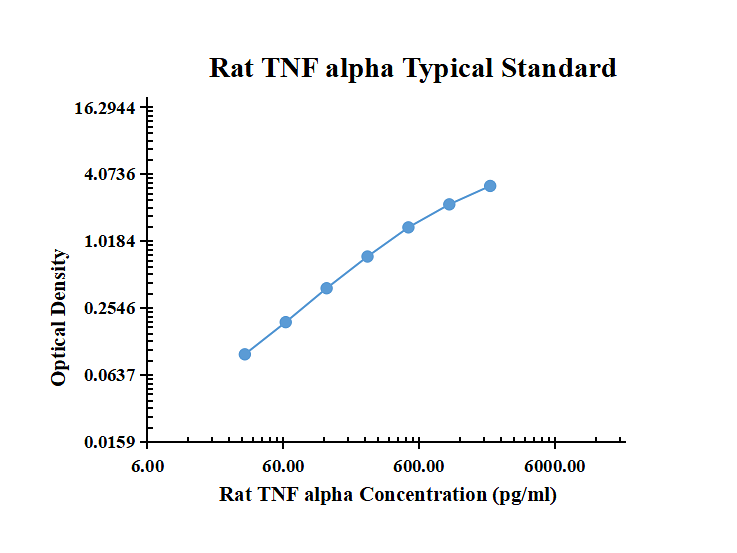Rat TNF alpha DTSet enzyme-linked immunoassay kit
| Specification | 96*5 Test;96T*15 Test |
|---|---|
| Standard Curve Range | 31.25 pg/ml-2000 pg/ml |
| Standard Curve Gradient | 7 Points/3 Folds |
| Number of Incubations | 2 |
| Detectable sample | Liquid phase sample of soluble substances. For example: serum, plasma, cell culture supernatant, tissue grinding liquid, etc. |
| Sample Volume | 50 μl |
| Type | Not Ready-to-Use |
| Test Duration | 120min |

| pg/ml | O.D. | Average | Corrected | |
|---|---|---|---|---|
| 0.00 | 0.0281 | 0.0270 | 0.0276 | |
| 31.25 | 0.1479 | 0.1731 | 0.1605 | 0.1330 |
| 62.50 | 0.2933 | 0.3043 | 0.2988 | 0.2713 |
| 125.00 | 0.6042 | 0.5920 | 0.5981 | 0.5706 |
| 250.00 | 1.1070 | 1.1240 | 1.1155 | 1.0880 |
| 500.00 | 1.9910 | 1.9430 | 1.9670 | 1.9395 |
| 1000.00 | 3.1240 | 3.0560 | 3.0900 | 3.0625 |
| 2000.00 | 4.2319 | 4.4089 | 4.3204 | 4.2929 |
Product Features
- Optimized capture and detection antibody pairings with recommended concentrations save lengthy development time
- Development protocols are provided to guide further assay optimization
- Assay can be customized to your specific needs
- Economical alternative to complete kits
Kit Content
- Capture Antibody
- Detection Antibody
- Recombinant Standard
- Streptavidin conjugated to horseradish-peroxidase (Streptavidin-HRP)
Other Reagents Required
DTSet Ancillary Reagent Kit (5 plates): containing 96 well microplates, plate sealers, substrate solution, stop solution, plate coating buffer (PBS), wash buffer, and assay buffer.
- 96 well microplates: YOUKE Life, Catalog # DSEP01. Plate Sealers: YOUKE Life, Catalog # DSSF01.
- Coating Buffer: 137 mM NaCl, 2.7 mM KCl, 8.1 mM Na2HPO4, 1.5 mM KH2PO4, pH 7.2-7.4, 0.2μm filtered . YOUKE Life, Catalog # DSCB01.
- Blocking Buffer: YOUKE Life, Catalog # DSBB01.
- Wash Buffer: 0.05% Tween® 20 in PBS, pH 7.2-7.4. YOUKE Life, Catalog # DSWB01.
- Assay Buffer: 0.5% BSA,0.05% Tween® 20,PBS Solution.YOUKE Life, Catalog # DSAB01
- Substrate Solution: Tetramethylbenzidine. YOUKE Life, Catalog # DSTS01.
- Stop Solution: 0.5mol/ml H2SO4. YOUKE Life, Catalog # DSSS01.
Product Data Sheet
Background: TNF alpha
Tumor necrosis factor alpha (TNF-alpha ), also known as cachectin and TNFSF1A, is the prototypic ligand of the TNF superfamily. It is a pleiotropic molecule that plays a central role in inflammation, immune system development, apoptosis, and lipid metabolism. TNF-alpha is also involved in a number of pathological conditions including asthma, Crohn's disease, rheumatoid arthritis, neuropathic pain, obesity, type 2 diabetes, septic shock, autoimmunity, and cancer.
Mouse TNF-alpha is synthesized as a 26 kDa type II transmembrane protein that consists of a 35 amino acid (aa) cytoplasmic domain, a 21 aa transmembrane segment, and a 179 aa extracellular domain (ECD). Within the ECD, mouse TNF-alpha shares 95% aa identity with rat, and 80% aa identity with canine, equine, feline, human, rabbit, and porcine TNF-alpha. It is produced by a wide variety of immune, epithelial, endothelial, and tumor cells. TNF-alpha is assembled intracellularly to form a noncovalently linked homotrimer which is expressed on the cell surface.
Cell surface TNF-alpha can both induce the lysis of tumor cells and virus infected cells, and generate its own downstream cell signaling following ligation by soluble TNF RI. Shedding of membrane bound TNF-alpha by TACE/ADAM17 releases the bioactive cytokine, a 55 kDa soluble trimer containing the TNF-alpha extracellular domain.
TNF-alpha binds the ubiquitous 55-60 kDa TNF RI and the hematopoietic cell-restricted 78-80 kDa TNF RII, both of which are also expressed as homotrimers. Both type I and type II receptors bind TNF-alpha with comparable affinity and can promote NFkB activation. Only TNF RI, however, contains a cytoplasmic death domain which triggers the activation of apoptosis. Soluble forms of both types of receptors are released into human serum and urine, and can neutralize the biological activity of TNF.

